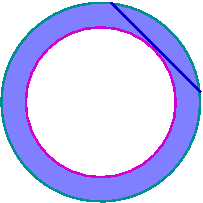
Take a circle C, and a chord in the circle. Now slide the chord around the circle. As you do this, the midpoint of the curve will trace out a smaller concentric circle. Call the area between the two circles A(C).
Now suppose you do the same thing with a larger circle C’ but with the same length chord? Will A(C’) be larger or smaller than A(C)?
Surprise: they will actually be the same area! In otherwords A(C) does not depend on what circle C you start with, only the length of the chord!
Presentation Suggestions:
From this fact, ask students if they can see quickly what the fixed area must be! [Hint: start with a circle whose diameter is the length of the chord.]
The Math Behind the Fact:
In fact, an even more amazing fact is true: take any convex shape C and place a chord of fixed length in it. Now slide as you slide the chord around C, the midpoint traces out another figure D. The area between C and D does not depend on what shape you started with!
How to Cite this Page:
Su, Francis E., et al. “Sliding Chords.” Math Fun Facts. <http://www.math.hmc.edu/funfacts>.
References:
R. Vakil, A Mathematical Mosaic, 1996.
Fun Fact suggested by:
Ravi Vakil

